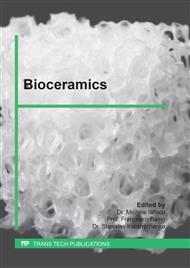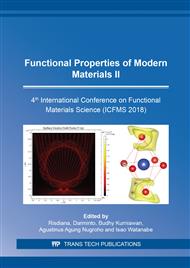p.119
p.126
p.133
p.139
p.145
p.151
p.157
p.163
p.169
Hydroxyapatite-Collagen Composite Made from Coral and Chicken Claws for Bone Implant Application
Abstract:
Synthesis of porous hydroxyapatite-collagen composites for bone implant applications has been carried out. Hydroxyapatite synthesized from coral by the precipitation method, while Collagen synthesized from chicken claws. Collagen formation was carried out by freeze-dry technique with variations in freezing time of 2, 4 and 6 hours at -80 ° C. The next process was by drying in a lyophilizer. Characterization of samples was carried out using Fourier Transform Infra Red (FTIR), Scanning Electron Microscopy (SEM), compressive strength test and cytotoxicity test with Microtetrazolium (MTT) assay. FTIR results proved that collagen uptake and hydroxyapatite combine chemically. This is indicated by the absorption of functional groups that did not coincide between collagen and hydroxyapatite functional groups with composites. SEM observations showed that the largest pore size was obtained at freezing for 2 hours which was 774 μm and the smallest in freezing for 6 hours was 640 μm. This pore size was an important parameter of the bone implant because it played a role in the osteoinductive process. The composite compressive strength test results for freezing 2 hours, 4 hours and 6 hours respectively was 737 KPa, 842 KPa and 707.7 KPa. The results of the cytotoxicity test with MTT showed the percentage of cell viability above 100%. This means that the Hydroxyapatite-collagen composite is non-toxic. So, the sample formed has qualified as a bone implant candidate.
Info:
Periodical:
Pages:
145-150
Citation:
Online since:
August 2019
Keywords:
Price:
Сopyright:
© 2019 Trans Tech Publications Ltd. All Rights Reserved
Share:
Citation:



